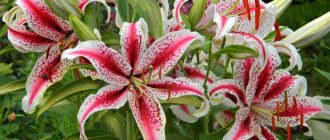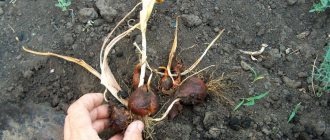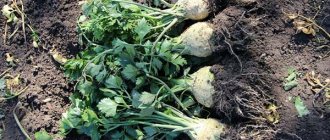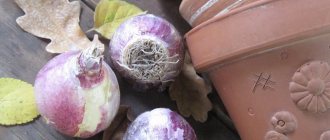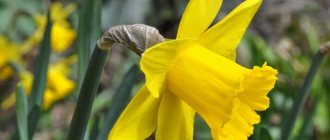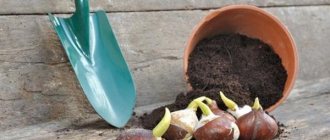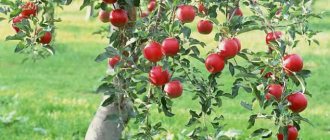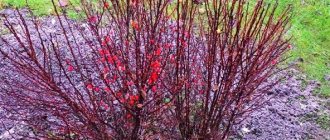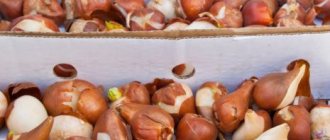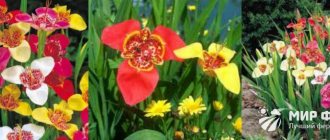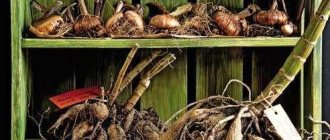- October 7, 2018
- Gardening tips
- Legina Marina
Hyacinth is a plant that delights both beginners and seasoned gardeners. Its name translates as “rain flower”. It really likes moisture, although it can survive a little drought. The bulb, which is a large bud, helps him in this.
The plant consists of fleshy leaves and a dormant shoot. Before the beginning of the growing season, this shoot is fed from the reserves of the bulb itself. It is this that ensures rapid development and spring growth. It is no secret that all bulbous plants must be dug up after flowering and provided with a full period of rest. Today we will talk about how to store hyacinth bulbs.
Rhythm of life
Half of the success depends on whether these rules are followed. Hyacinth has its own rhythm of life, so the future owner should definitely become familiar with it. This will avoid mistakes. In principle, it is not so difficult to figure out how to store hyacinth bulbs; the main thing is to know the annual cycle of the plant.
After the plant fades, you need to cut off the wilted inflorescence from the bulb.
Continue watering the soil for some time until the leaves completely dry out.
After this, watering is stopped, and the bulbs from the pot are transplanted. For the next three months, it is best to transplant them to a dark, cool place. During this time, the hyacinth should gain strength and form new bulbs.
A new cycle begins when fresh green leaves are produced. Now the bulb is planted in fresh soil and moved closer to the window. Sunlight is required for further growth and development.
But this is a theory, but in practice a million more questions arise, each of which requires an answer. Therefore, we will figure out how to store hyacinth bulbs.
What to do with hyacinth after flowering in a pot
Hyacinths are perennial bulbous plants given to humans by the nature of the Mediterranean and Central Asia. Compact bushes with beautiful bright inflorescences and a pleasant aroma have moved from garden beds to apartments. The practice of forcing hyacinths into pots for the holidays has become widespread. Bulbous plants have a short period from awakening to flowering. A technology has been developed to speed up their growing season.
Interesting fact. The outer scales of hyacinth bulbs repeat the color of the flower. In purple varieties they are purple, in white varieties they are light golden.
Hyacinths begin to bloom in February-March, although in the middle zone they do not bloom until April. While there is snow outside, they delight with the spring aroma and beautiful inflorescences. There are plants colored in pink, burgundy, and purple shades. Their flowering period will not last longer than two weeks. After the hyacinth in the pot has finished flowering, you will have to decide what to do with it next.
Initially, a flower grown using forcing technology is considered disposable. He spends a lot of effort on the early growing season. But if you wish, you can extend its life. The withered peduncle is cut off, but not completely. It, together with the rest of the ground part, participates in the accumulation of nutrients. Removing the arrow is associated not only with a decorative component. After flowering, seed formation begins, depleting the plant.
The wilting of the peduncle means the beginning of an important cycle - preparation for the next growing season. After the hyacinth has bloomed, what to do with the bulb? It is dried and stored until autumn planting in the ground.
Rest period is very important
The duration of flowering depends on the variety, as well as on weather conditions. If it is warm and humid, the bulbs will continue to grow even during flowering. This means it will last much longer. But as soon as the growth and development of the buds ends, a new stage begins. This is the growth of the bulb and the storage of nutrients. The better this stage goes, the more beautiful the flowering will be next year. And for its successful completion, you need to familiarize yourself with the recommendations regarding the care of this important part of the flower. It is necessary to properly store hyacinth bulbs after digging, and ensure their further successful growth and development.
Will the hyacinth bloom?
Those who prefer to throw away bulbs that have been forced are partly right. We are often sold Dutch selection hyacinths in pots; they are characterized by poor winter hardiness. And if there is no flowering the next year, the bulb is probably dead.
But don't rush to get upset. Numerous experiences of amateur flower growers (just like you and me) have been able to achieve flowering of forced bulbs! It’s just that very often (and most likely) it’s not the time yet. Forcing is a lot of stress for the plant. Usually the next year the plant rests, gains strength, and blooms only two years after forcing (that is, in the spring).
Hyacinth has bloomed
When the arrow dries out, it needs to be removed. Sometimes flower growers leave it, but this is completely wrong. The plant will waste nutrients on them, which will affect the condition of the bulb. That is, caring for hyacinths after flowering involves immediate pruning of the shoots. Moreover, this must be done even before the formation of seed pods. Otherwise they will weaken the bulb.
Moreover, Dutch flower growers recommend removing even the flower shoot from plants of the first and second years of forcing, so that it does not take away nutrients. After all, the larger and healthier the bulb, the more luxurious the inflorescences will be on future shoots.
How to properly prepare hyacinths for removal from the ground
The first measures to prepare primroses for the dormant period begin immediately after flowering has completed.
- removing flower stalks;
- bulb ripening.
You should carefully cut off the flower shoot to prevent the formation of seed pods. Hyacinth seeds are of value only to professional breeders. In general, the formation and ripening of seeds depletes the bulb and is undesirable.
For young hyacinths, it is advisable to remove the arrows before flowering. This contributes to the formation of large bulbs, which will delight you with long flowering next season.
The leaves of hyacinths should not be forcibly removed so as not to interfere with the ripening of the bulbs. It is necessary to wait until the leaf rosette completely withers. Dried leaves of hyacinths are removed immediately before digging them up.
The cessation of flowering does not serve as a reason to stop watering and fertilizing. Drying of leaves is not a reason to stop watering and fertilizing. Twice a month, the bulbs are fed with complex fertilizers for deciduous plants.
The process of dying off of hyacinth leaves can be accelerated by reducing watering and stopping it completely no earlier than the end of June.
Hyacinth leaves
In addition to the flower arrow, the plant also has leaves. There is no need to remove them. Hyacinth receives nutrients not only from the soil, but also through regular fertilizing and watering. The leaves should dry out naturally. To do this, from the beginning of June the plant stops watering. After about a month, the leaves will dry completely. Then they can be carefully separated from the bulb. Now you can select a suitable box, fill it with fresh soil, sawdust or sand, and mulch the top.
Bulbs after flowering
Experienced gardeners recommend not leaving them in one place for more than three years. Even in the southern regions this leads to aging of the bulb. On the other hand, during this time they manage to grow in size and babies appear on them. In this case, they can be dug up and planted.
But Dutch breeders (they are well versed in this matter!) recommend not leaving the bulbs in the ground after flowering and in the first year, especially if this concerns fastidious varieties. After wintering they may not bloom well. Therefore, it is best to dig up the bulbs, inspect, sort and process them. After this, they can be sent for storage.
We are approaching the most difficult and important stage in growing hyacinths. Every gardener should know how to store hyacinth bulbs at home. This ensures good blooms year after year. Purchased or pre-dug bulbs must first be thoroughly dried, freed from soil residues, and cleared of excess scales. Be very careful because babies may appear under the scales.
How to preserve the bulb yourself and care for hyacinth at home after flowering?
In winter, flower shops have a large selection of forced hyacinths. Large bulbs with green leaves and a peduncle ready to bloom are purchased to decorate an apartment or as a gift. After two weeks, when the hyacinth has faded, what should you do at home? The main thing is not to rush to stop watering and trim the leaves. You can save the bulb until autumn and plant it in open ground or a spacious pot.
How to dig up bulbs correctly
At first glance, there is nothing complicated in this procedure. But if we decide to thoroughly study how to preserve hyacinth bulbs, then we need to discuss this issue in detail. Digging up primroses helps preserve planting material. Bulbs tend to dry out and degenerate when left in the soil continuously. That is, digging stimulates life expectancy. By regularly repeating this procedure, you can enjoy the flowering of the same bulb for ten years.
The bulbs are dug up 2 months after all the leaves have completely dried. A few days before this, watering and fertilizing the plants is stopped. It is important to carefully clean the dug up bulbs from the soil, rinse them in warm water and leave them in the air to dry.
It is necessary to prepare ventilated containers in advance. You can take wood or cardboard. But polyethylene or sealed containers are absolutely not suitable. Free access of air to the bulbs is a prerequisite. The dried bulbs are sorted out and carefully inspected for damage or damage from diseases and pests. Excess scales are removed. Grown-up children are separated from their mother, and immature children are left behind. Typically, ripening occurs during the dormant period.
Here we come to how to store hyacinth bulbs after flowering. They need to be placed at a short distance from each other so that the scales do not touch. Laying in two layers is allowed if there is a lot of planting material. But in this case, the bulbs need to be constantly turned over to ensure even drying. After drying, it may be necessary to separate the flakes again.
Temperature
In order for the bulbs to rest well and produce strong shoots in the future, you need to provide them with good rest. First they need to be placed in a cool place. Then gradually reduce the temperature to ensure a smooth transition to the rest period. Therefore, it is important to immediately think about where to store hyacinth bulbs.
The room should not be humid and free air circulation is very important. In August, hyacinths can be planted in the ground for the winter. Then the gradual decrease in night temperatures will do all the work for you. You can grow hyacinth in a pot so that it blooms by a certain date.
Three stages of hyacinth development
The development cycle of hyacinth throughout the year can be divided into three periods:
- Spring growing season (lasts 3 months) - appearance of leaves, flowering, formation of daughter bulbs.
- Summer dormancy (3 months) - begins after the leaves dry out; during this period the bulb should be at a temperature of about 25 ° C.
- Winter dormancy (6 months) - lasts from mid-autumn until spring leaf growth.
All three periods are necessary for the development of a bulbous plant. Moreover, they can be created artificially, achieving flowering of hyacinth at unusual times. The technology of forcing flowering is called forcing. It is these forced hyacinths that we buy in pots in winter and early spring.
To grow blooming hyacinth, you need to maintain the correct temperature throughout the year.
Why dig up hyacinths? Is it necessary?
If the variety is unpretentious, and amateur flower growers also confirm this with many years of practice, you can do without digging.
But according to all the rules:
- Firstly, hyacinths can be returned to their original planting site only after 5 years; these years can be planted in other places in the flower garden.
- Secondly, to form a strong rudiment of the future new peduncle, hyacinths need warmth. The temperature in the soil is lower than in the room. In addition, if the summer is damp, the bulbs may rot. And one more thing: even under favorable weather conditions, hyacinths that have survived the summer in the ground bloom much weaker the next year.
You can dig up hyacinths only after:
- They have bloomed
- The leaves have fallen and their tips have dried out.
- It's June - early July.
So, it is possible to preserve forced hyacinth bulbs if you do everything correctly. But you will have to take care of it a little more carefully than usual. By caring for hyacinth in a pot, we artificially extend not only its growing season, but also its future life.
Autumn planting
The flowerbed is prepared in advance, a month or two in advance. The soil is well dug to a depth of 20-30 cm, since the roots of these plants go deep. Adding compost or rotted manure to the soil for digging (but no later than a month before planting) has a beneficial effect on flowering. You can also refill the soil with autumn complex fertilizer.
In central Russia, it is recommended to plant hyacinths in the first ten days of October. If planted early, especially if the autumn is warm, hyacinths may begin to grow and die from frost. And 2-3 weeks before frost, the bulbs will have time to take root, but not germinate. For this, the optimal planting period is considered to be the end of September - the beginning of October.
In the fall, as a rule, and September, the bulbs are planted in the ground to a depth of 1.5 - 2 cm. In general, it is believed that the planting depth of the bulb depends on the diameter. Large specimens are buried 18-20 cm, measured from the bottom. On clay soils, planting should be shallower. You can pour a 2-centimeter layer of sand at the bottom of the hole; hyacinths like it.
The bulbs are lowered into the hole bottom down, sprinkled with soil about half the bulb, and then with soil.
The hyacinth has faded, but life goes on!
It’s alive, and very often children even grow up in a pot next to each other. Well, is it possible to throw this away? In order to preserve the hyacinth that has been forced, you need to continue to care for it! This is the most important rule! The flowering period must necessarily be replaced by a dormant period, but the transition between them must be gradual.
Caring for faded hyacinth step by step:
(method No. 1 is the easiest)
- After the hyacinth has faded, the peduncle should be trimmed (but not too short, leaving 10-15 cm is enough). Leave the leaves.
- Now you need to gradually reduce watering. Water faded hyacinth only as the soil dries out, not as much as during flowering, but from time to time.
- Gradually the leaves will turn yellow, and around mid-May you need to stop watering completely and wait until the leaves completely dry out.
- The leaves have dried out - we cut them off and take out the bulbs. You need to carefully remove the bulb from the pot, clean it from the soil, and cut off the dry leaves.
- Next, you need to dry the bulb a little in a dark, warm, ventilated room at a temperature of +18 to +22 degrees. And store in such conditions until autumn planting. A cardboard box or box is perfect for storage, but never a bag.
Before drying, the bulbs can be pickled in a solution of potassium permanganate or Maxima. You can store the bulbs at home. Hyacinths are not stored in the refrigerator. They are planted in open ground at the end of September - beginning of October. Before the onset of frost, the bulbs will have time to take root in the soil. In the spring, such hyacinths may not bloom, but only next year.
Method number 2:
(let's call it “more complicated”)
- Part of the peduncle with fading flowers is cut off. Don't cut it too short, just leave 10-15 centimeters. Leave the leaves! On YouTube, in one of the videos, I came across advice to trim hyacinth leaves immediately after flowering, while they are still green. This is a grave mistake! The leaves should dry naturally. The transition of hyacinth to the resting phase should be gradual. The faded hyacinth still needs leaves to nourish the bulb itself. By depriving the plant of leaves, we deprive the bulb of nutrition, and it will not be able to prepare as well as possible for the dormant period.
- So, the peduncle was trimmed, the leaves were left. Now, together with the earthen ball, they transfer the plant into a larger pot so that the bulbs develop on their own and grow children. Plant so that the root collar is not buried. Why does hyacinth need a spacious pot? The fact is that forced flowers are sold in very small pots and there is practically no land there. But our task is for the hyacinth to slowly enter a state of rest, develop its bulb, and stock up on nutrients before a long summer vacation.
- The transplanted plant will feel better in a cool, bright place. Hyacinth should be watered sparingly after flowering. Some gardeners argue that it is better to do this in a tray. And some time after transplantation, you can feed it with a weak solution of complex fertilizer.
- Then there are two ways: either the hyacinth is kept in a pot at home, or in May it is transplanted into open ground in a garden bed to prepare for the rest period.
- As the leaves wither, watering is gradually reduced and then stopped altogether. Over time, the leaves will dry out completely - then the bulb is removed from the ground, peeled, dried and sent for storage until the fall, until winter planting in the ground.
- It is better to store hyacinth bulbs in a cardboard box in a dry, dark, ventilated place (for example, under the bed). Shelf life: 2.5 - 3 months. This is how long the resting period of hyacinth lasts.
- Hyacinths are planted in the garden in the fall, in September or early October. The bulb should take root, but not grow green mass, so there is no need to rush into planting.
This method, what and how to do it, was described in detail and in a very accessible way in one of the issues of the Gardener's Garden magazine:
Three important steps
- For the first 8-9 weeks, the air temperature is maintained within +20 °C. During this time, the scales will dry out. The duration can be shortened by raising the temperature to +30 degrees. In this case, it is recommended to cover the bulbs with sphagnum moss. This retains the necessary moisture and prevents the bulbs from drying out.
- Over the next four weeks, the temperature is gradually lowered to +18 degrees, while maintaining a high level of humidity. To do this, planting material and sphagnum are periodically moistened with warm water.
- In the last week, the temperature should be lowered to +10 degrees. It is extremely important to avoid sudden changes in air temperature to avoid stressing the bulbs. If you live in a region with a mild climate, then you can skip this stage, because the temperature regime of the last week increases frost resistance.
Plant bulbs contain oxalic acid. It may cause skin irritation. Therefore, in order to avoid undesirable consequences, you must adhere to personal safety rules.
How to store hyacinth bulbs in the refrigerator
Sometimes you have to really rack your brains to provide the necessary conditions. The apartment is too hot, not everyone has a cellar. And on the bottom shelf the conditions are just right. But you need to take into account that new systems equipped with the No Frost system draw out moisture, which can lead to drying out and death of the bulbs. To prevent this from happening, it is recommended to line the box with slightly moistened moss or peat and periodically spray it with warm water.
How and when to plant hyacinths
Your planting material will gain strength until autumn. At this time, the development of hyacinth bulbs does not stop. How to preserve the maximum amount of them at home? You just need to follow the recommendations provided. In the meantime, we need to prepare a place for the future flower garden. To do this, you need to choose an area with good drainage that is not prone to waterlogging. If this is not available, high beds are used.
The soil is dug up and fertilized in advance. It is best to do this in advance, in the summer. Leave nitrogen fertilizers for the spring; now only potash or organic fertilizers are needed. The rested bulbs are transferred to the flower garden at the end of September or beginning of October. At the same time, avoid planting damaged or diseased bulbs and be sure to treat them with potassium permanganate. Large bulbs are planted to a depth of no more than 18 cm according to a 15 x 15 cm pattern. The thickness of the soil above the top of the bulb should not exceed 5 cm. It is recommended to make a sand cushion under the bed. It will protect against waterlogging.
Conditions for preserving hyacinth bulbs
Before storage, dried bulbs are calibrated and treated with drugs against pests and diseases. This can be done in 2 ways: soak in a solution or spray with a spray bottle. More often they use the Maxim fungicide, dissolving 2 ml in 1 liter of water and keeping the bulbs in it for half an hour, or use another similar disinfectant.
Hyacinths: flowers, plant, home care
Large and small bulbs are stored separately in paper bags or cardboard boxes, with the names of the varieties labeled.
Additional Information. The outer scales of the bulbs are different in color: dark varieties are purple, light varieties are golden.
The color of the scales of the bulbs depends on the color of the inflorescences. Storage, during which flower buds are laid, is divided into 2 stages:
- The first, two-month period, takes place at 25-28°C.
- The second, pre-planting, lasts 1 month, the temperature is maintained at 18°C, monitoring air humidity (50-60%). If it is insufficient, the bulbs will dry out, and fungal diseases occur at high humidity.
During storage until autumn, planting material is periodically inspected to identify diseased specimens.
Planting care
Be sure to mulch the bed. Dry straw, pine needles, sawdust and dry leaves can be used as mulch. After planting, hyacinths are not watered. With the onset of autumn rains they will have enough moisture, and in the spring the melting of snow will allow them to germinate quickly. With the onset of spring days, you need to remove the layer of mulch, because plants will not be able to break through it.
